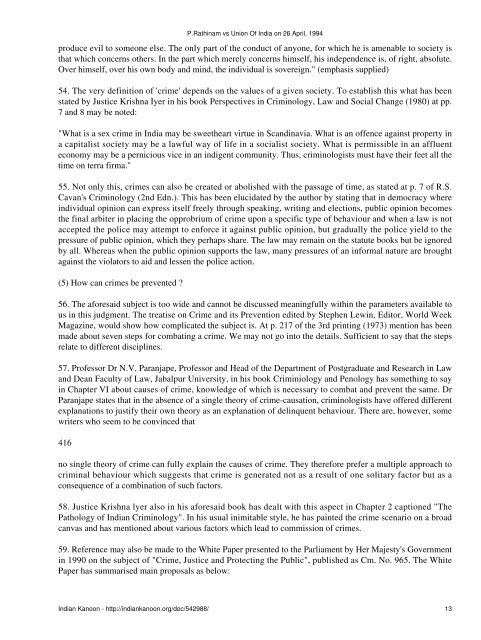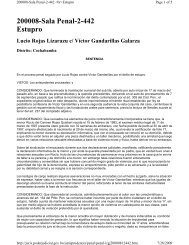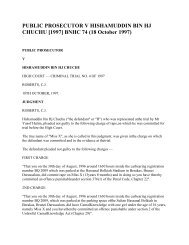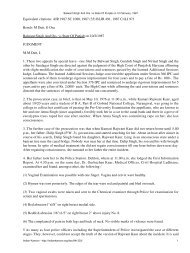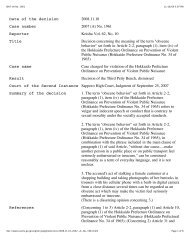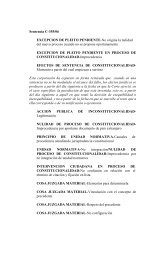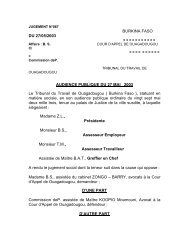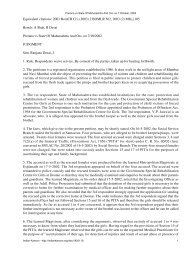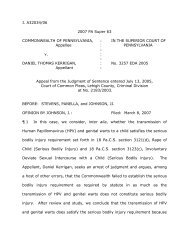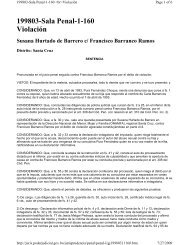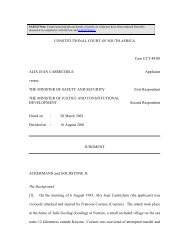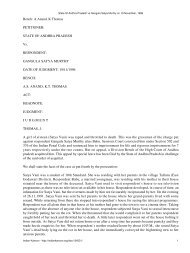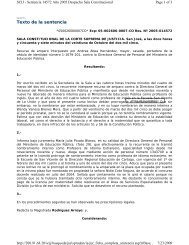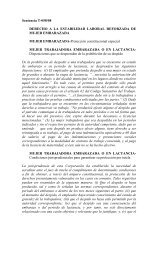P. Rathinam v. Union of India - Cornell University
P. Rathinam v. Union of India - Cornell University
P. Rathinam v. Union of India - Cornell University
- No tags were found...
Create successful ePaper yourself
Turn your PDF publications into a flip-book with our unique Google optimized e-Paper software.
produce evil to someone else. The only part <strong>of</strong> the conduct <strong>of</strong> anyone, for which he is amenable to society isthat which concerns others. In the part which merely concerns himself, his independence is, <strong>of</strong> right, absolute.Over himself, over his own body and mind, the individual is sovereign." (emphasis supplied)54. The very definition <strong>of</strong> 'crime' depends on the values <strong>of</strong> a given society. To establish this what has beenstated by Justice Krishna Iyer in his book Perspectives in Criminology, Law and Social Change (1980) at pp.7 and 8 may be noted:"What is a sex crime in <strong>India</strong> may be sweetheart virtue in Scandinavia. What is an <strong>of</strong>fence against property ina capitalist society may be a lawful way <strong>of</strong> life in a socialist society. What is permissible in an affluenteconomy may be a pernicious vice in an indigent community. Thus, criminologists must have their feet all thetime on terra firma."55. Not only this, crimes can also be created or abolished with the passage <strong>of</strong> time, as stated at p. 7 <strong>of</strong> R.S.Cavan's Criminology (2nd Edn.). This has been elucidated by the author by stating that in democracy whereindividual opinion can express itself freely through speaking, writing and elections, public opinion becomesthe final arbiter in placing the opprobrium <strong>of</strong> crime upon a specific type <strong>of</strong> behaviour and when a law is notaccepted the police may attempt to enforce it against public opinion, but gradually the police yield to thepressure <strong>of</strong> public opinion, which they perhaps share. The law may remain on the statute books but be ignoredby all. Whereas when the public opinion supports the law, many pressures <strong>of</strong> an informal nature are broughtagainst the violators to aid and lessen the police action.(5) How can crimes be prevented ?56. The aforesaid subject is too wide and cannot be discussed meaningfully within the parameters available tous in this judgment. The treatise on Crime and its Prevention edited by Stephen Lewin, Editor, World WeekMagazine, would show how complicated the subject is. At p. 217 <strong>of</strong> the 3rd printing (1973) mention has beenmade about seven steps for combating a crime. We may not go into the details. Sufficient to say that the stepsrelate to different disciplines.57. Pr<strong>of</strong>essor Dr N.V. Paranjape, Pr<strong>of</strong>essor and Head <strong>of</strong> the Department <strong>of</strong> Postgraduate and Research in Lawand Dean Faculty <strong>of</strong> Law, Jabalpur <strong>University</strong>, in his book Criminiology and Penology has something to sayin Chapter VI about causes <strong>of</strong> crime, knowledge <strong>of</strong> which is necessary to combat and prevent the same. DrParanjape states that in the absence <strong>of</strong> a single theory <strong>of</strong> crime-causation, criminologists have <strong>of</strong>fered differentexplanations to justify their own theory as an explanation <strong>of</strong> delinquent behaviour. There are, however, somewriters who seem to be convinced that416P.<strong>Rathinam</strong> vs <strong>Union</strong> Of <strong>India</strong> on 26 April, 1994no single theory <strong>of</strong> crime can fully explain the causes <strong>of</strong> crime. They therefore prefer a multiple approach tocriminal behaviour which suggests that crime is generated not as a result <strong>of</strong> one solitary factor but as aconsequence <strong>of</strong> a combination <strong>of</strong> such factors.58. Justice Krishna lyer also in his aforesaid book has dealt with this aspect in Chapter 2 captioned "ThePathology <strong>of</strong> <strong>India</strong>n Criminology". In his usual inimitable style, he has painted the crime scenario on a broadcanvas and has mentioned about various factors which lead to commission <strong>of</strong> crimes.59. Reference may also be made to the White Paper presented to the Parliament by Her Majesty's Governmentin 1990 on the subject <strong>of</strong> "Crime, Justice and Protecting the Public", published as Cm. No. 965. The WhitePaper has summarised main proposals as below:<strong>India</strong>n Kanoon - http://indiankanoon.org/doc/542988/ 13


